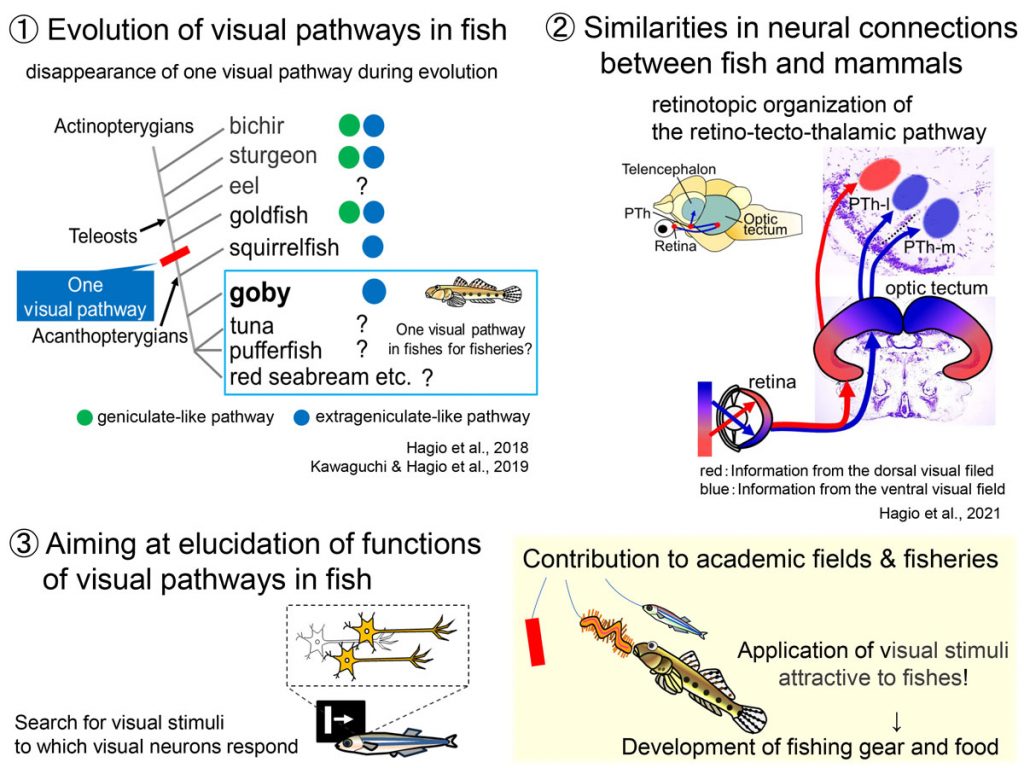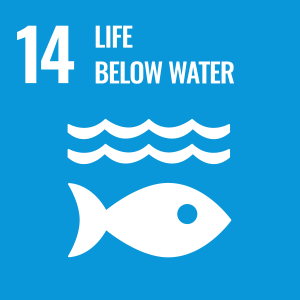Fish Neuroscience
Fisheries Science

HAGIO Hanako
Starting year 2021
Nagoya University
Graduate School of Bioagricultural Sciences
Assistant Professor
Research Areas:Life Science
Environmental Science/Agriculture Science
Natural Science
Research fields
Research Interests
The brain of fish
visual system
gustatory system
eel aquaculture
novel optogenetic tools
Professional Memberships
The Japanese Society of Fisheries Science
East Asia Eel Society
Society for Neuroscience
J.B. Johnston Club for Evolutionary Neuroscience
Main research topics
Central visual system of fish – How do fish look at the world?
Most vertebrates including fish recognize food and predators for survival, as well as individuals of opposite sex for reproduction by means of sensory systems. The visual sensory system is especially important for many vertebrates. While it has been recognized that elucidation of vision of fish is extremely important in the academic field and fisheries industry, the visual system of fish is poorly understood with fragmental studies. In order to understand vision of fish, it is the first step to reveal visual pathways from the retina to the telencephalon.
Many vertebrates, such as mammals, possess two visual pathways. In teleosts, which include most fish species, the goldfish and carp have two visual pathways, while the squirrelfish has only one. We examined visual pathways of the yellowfin goby Acanthogobius flavimanus, which is an acanthopterygian like holocentrids, and several other fish species. Our studies suggest that the common ancestor of actinopterygians possessed two pathways, and later one pathway was lost in the common ancestor of acanthopterygians, which include many fishes for fisheries (Figure①). Our studies also suggest that the retinotopic organization is retained through the optic tectum to the diencephalic visual relay nucleus, or the nucleus prethalamicus (PTh), in teleosts, as in mammals. Thus, we revealed similarities in neural connections between fish and mammals (Figure②).
We identified a gene specifically expressed in the diencephalic visual relay nucleus and confirmed that neurons in the nucleus responded to various visual stimuli using transgenic fish and microscopic live imaging analyses (Figure③). We try to elucidate similarities and differences in functions of two or one visual pathways. In the future, we would like to find visual stimuli attractive to fishes and utilize its characteristics in fishing gear and food to contribute not only to the academic field, but also to the fisheries industry. In addition, we are investigating “control mechanisms of a special feeding behavior of fish using new transparency technique” and developing “novel optogenetic tools controlling activities of neurons” in collaboration with other neuroscientists.





Representative papers
Hagio H, Kawaguchi M, Abe H, Yamamoto N. Afferent and efferent connections of the nucleus prethalamicus in the yellowfin goby Acanthogobius flavimanus, J. Com. Neurol. 529, 87-110, 2021.
https://doi.org/10.1002/cne.24935
Bloch S§,Hagio H§, Thomas M, Heuzé A, Hermel J.M., Lasserre E, Colin I, Saka K, Affaticati P,
Jenett A, Kawakami K, Yamamoto N, Yamamoto K. Non-thalamic origin of zebrafish sensory
nuclei implies convergent evolution of visual pathways in amniotes and teleosts, eLife, 9, e54945,
2020.(§Bloch S and Hagio H contributed equally to this study.)
https://doi.org/10.7554/eLife.54945
Research URL
researchmap https://researchmap.jp/hana-brain
Laboratory Website https://fish-biology-nu.wixsite.com/fish-biology-nu
Global issues to be solved through this project
Clarification of higher visual centers of fish and improvement of eel aquaculture technology
Fish is an important food resource in the world and consumption of fish is increasing. We try to address two global challenges to solve global food problems through researches that contribute to the fisheries industries through more efficient catches and aquacultural production of fish.
The first issue is “elucidation of the visual system and higher cognitive abilities of fish”, because fishermen and fisheries industry hope developments of fishing gear and food that are attractive to fish. We try to find visual stimuli that many neurons respond to and investigate whether fish actually recognize the stimuli through international collaborative researches. In the future, we will develop fishing gear that enables efficient catches of fish. The second issue is “improvement of eel aquaculture technology by means of neuroscientific approaches”, which is very important for the aquaculture. We will develop new feed using neuronal activities as an index, and dramatically improve the survival and growth rates of eel larvae. We want to achieve massive productions of lower-priced eels and create a future where anyone can eat eels at any time.
Interview
No interview
News
-
お知らせ
Two research results from the research group led by T-GEx Fellow Dr. HAGIO Hanako, Nagoya University, Nagoya University, have been published in the biomedical and life science journal “eLife”.
-
お知らせ
T-GEx Fellow Dr. HAGIO Hanako, Nagoya University, received the 38th Inoue Research Encouragement Award.
-
お知らせ
The 2nd Kick-off meeting for AY2022 was held.
-
お知らせ
The name was changed to T-GEx Fellow and T-GEx Associate.
-
お知らせ
Academic Mentor for FY2021 T-GEx Fellows has been decided.
-
お知らせ
Kick-off meeting for AY2021 T-GEx Fellows was held.
-
お知らせ
The 8 T-GEx Fellows were selected for AY2021 T-GEx program.

